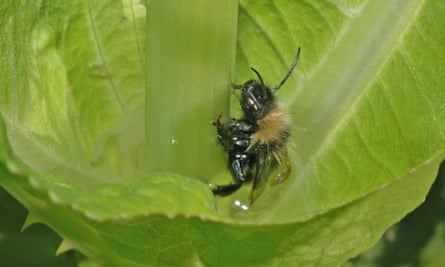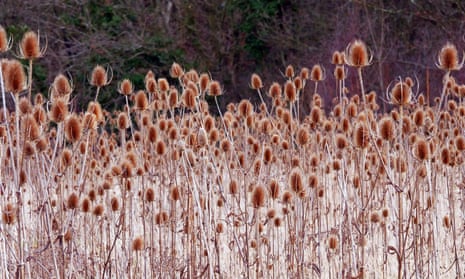The shoulder-high, prickly stems of dead teasels, Dipsacus fullonum, remain upright throughout winter, providing food for birds even when all else is hidden under snow.
We often encounter a scattering of these gaunt reminders of summer, usually growing on disturbed waste ground. Today, we walked among hundreds of them, standing like an army of sun-bleached skeletons, in a field on the outskirts of the city. A charm of goldfinches bounded ahead of us, settling to peck seeds from the cone-shaped, bristly seedheads.

Teasels are biennial wild flowers, but these were purposely sown here two years ago, for the benefit of birds and bees. Bumblebees find their densely packed lilac florets an easily accessible source of nectar and pollen, collected with minimal expenditure of energy simply by walking over the inflorescences. But there is a menacing aspect to the relationship between this plant and its pollinators.
Its paired, cauline leaves form a cup around the flowering stem; in the words of the 16th-century herbalist John Gerard they are “so fastened, that they hold dew and raine water in the manner of a little bason”. These aerial pools, glinting in sunshine, attract insects and soon accumulate drowned hoverflies, wasps and sometimes bumblebees, which visited to drink.

Escape is difficult if insects fall in. Francis Darwin, the great evolutionary biologist’s son, noted that the teasel’s stem, rough and prickly for most of its length, is so smooth and slippery immediately above the water surface that waterlogged insects struggle to climb out. He wondered if these plants might be the nearest equivalent in Britain’s flora to the carnivorous trumpet pitchers (Sarracenia spp) of the New World.
Teasels fail the strict criteria for joining that exclusive club because they do not secrete enzymes to digest drowned victims. But they do benefit from the corpses’ bacterial decay; in 2011 researchers at Roehampton university demonstrated that insect-supplemented teasels produce up to 30% more seed than those restricted to a purely photosynthetic diet.
There is a gruesome economy in this plant’s exploitation of its insect workforce, where some of its pollinators fall victim to those “little basons” and so provide a nutrient boost for seeds whose development they initiated.

Comments (…)
Sign in or create your Guardian account to join the discussion